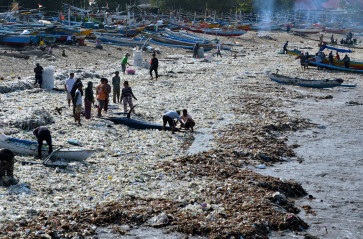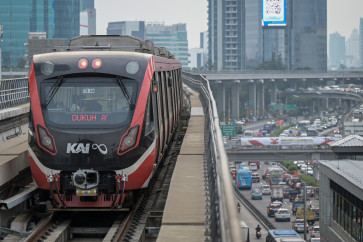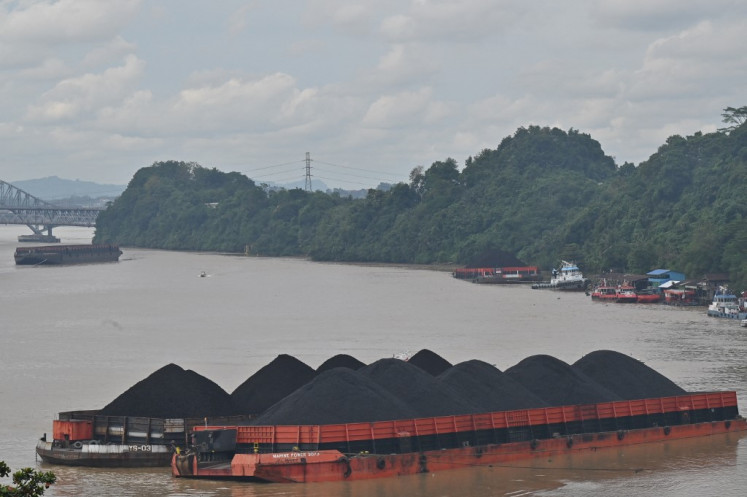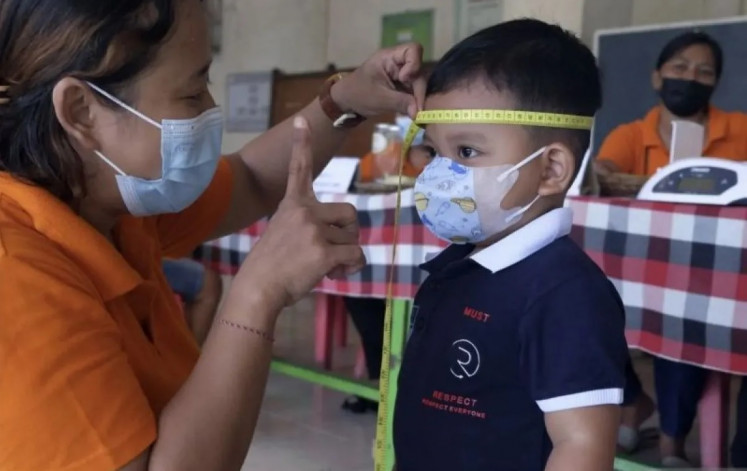Bandung Photography Triennale 2022 highlights the future of the Earth
Change text size
Gift Premium Articles
to Anyone
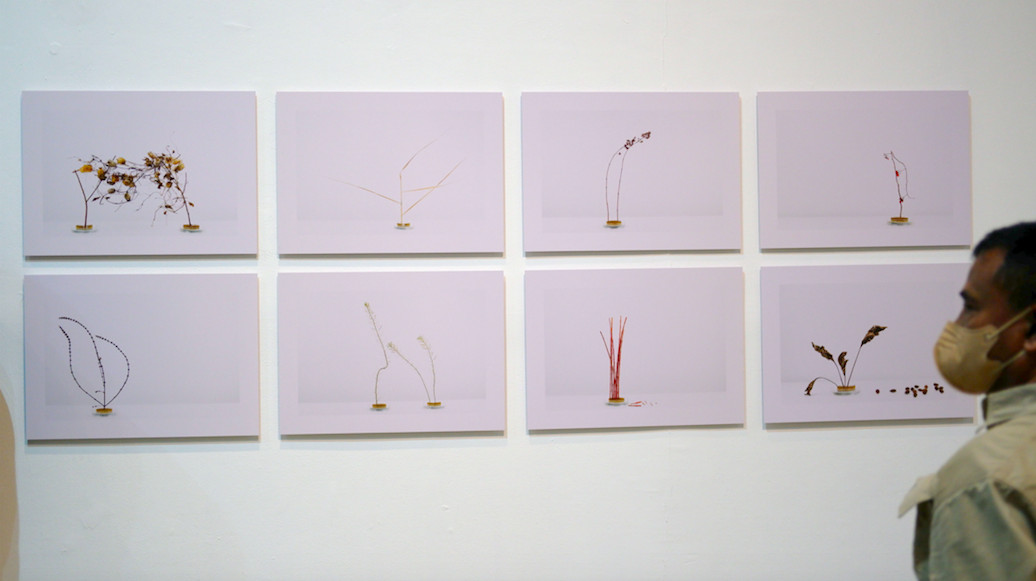
A
n impending sense of doom – the first Bandung Photography Triennale opens strong with a bleak dialectic about the future.
On Sept. 8, Bandung Photography Triennale 2022, under its big theme Future is Now: Skepticism, New Reality and Infinities, kicked off its series of exhibitions and satellite programs held in various venues across the city, involving 34 artists from across the globe – including Indonesia, Chile, the United States, Poland and Taiwan, among others.
Initiated by Bandung-based photography collective Komvni and curated by Asmudjo Jono Irianto and Henrycus Napitsunargo, the triennale, as noted in its curatorial notes, “seeks to involve artists to participate in responding to issues related to new realities, infinity and skepticism regarding the future of the earth’s ecosystem through the photography media''.
Its first exhibition, Dystopian Diffraction: Sign of Warning taking place at Selasar Sunaryo Art Space’s Bale Tonggoh, offers an unsettling dialogue on the future – or the absence of it – signified by the heart-wrenching state of the present.

Beyond literal representation
“The problem is that photography is a very popular medium, or can be said as the most popular visual medium,” Henrycus, one of the curators of Bandung Photography Triennale 2022, told The Jakarta Post at Selasar Sunaryo Art Space on Sept. 8.
For most people, differentiating between photojournalism and fine art photography is not a menial task.
“Everyone does [photography], from even camera-equipped smartphones to state-of-the-art cameras. But articulating works to enter the realm of arts is difficult,” Henrycus said as he leaned back into his seat, holding a wooden smoking pipe in his right hand.
“[It is] quite difficult to do and quite difficult to read,” he continued. “Because it’s so popular, people are used to interpreting photography in terms of the way they read things on a daily basis.” Photography art goes beyond the literal representation of the scene or subject. “What does a glass represent? What does a person represent? Metaphors.
“There’s no difference compared with other mediums in art. [...] They treat photography as a medium. They still create authentic artwork, and often, in photography, used as a critique,” Henrycus added.
“Because [photography] is the one that is most present within the general public. After World War II, humans saw the world through photography. Now it is getting more co-opted and radical.”
Regarding how the triennale curated its 34 artists into groups spread across five significant art spaces in Bandung—which are Selasar Sunaryo Art Space, NuArt Sculpture Park, Ruang Dini, Lawang Wangi Creative Space and Orbital Gallery—Henrycus noted that they did not categorize the artists based on their backgrounds or techniques, but more onto the “tendency of their practices”.
“But actually, the emphasis is on what it is that they are targeting. What it is that they criticize.”
Asleep at the wheel
The first exhibition of the series in the triennale—displaying the works of Indonesian artists Agus Heru Setiawan, Hari Krisnadi, Patriot Mukmin, Utami Dewi Godjali, alongside Anna Kedziora (the Philippines), Jim Ramer (the United States), Lavender Chang (Singapore), Sabrina Asche (Denmark), Shiho Yoshida (Japan) and Yong Hwan-Lee (South Korea) – came across as compact yet powerful, concise yet rattling and physically disorienting at times, particularly noting Patriot Mukmin’s works and also Utami’s hand-turned kaleidoscope.
From the eerily similar approach of Agus and Kedziora’s works in honoring now-nonexistent organic beings in a particular area to Ramer and Asche’s highlighting of systemic ignorance, the exhibition gives off an almost overwhelming, feverish feeling of helplessness befitting the subtheme. It is as if humanity has been sleeping while having its hands firmly planted to wheel, oblivious of its current surroundings.
The subthemes that were created from the triennale’s main theme, The Future is Now: Skepticism, New Reality and Infinity, according to Heru Hikayat, Selasar Sunaryo Art Space’s in-house curator, were not something predetermined but were formed quite organically as the committee started to gather the participating artists’ works.
“But the subthemes were entirely compiled by Kang [brother] Icus [Henrycus’ nickname] and Pak Asmudjo,” added Bob Edrian, the in-house curator of NuArt Sculpture Park, the venue of the triennale’s fourth main exhibition.
“We, the venue’s curators, were in charge of compiling the narratives [of the subthemes] and interpreting the works of the participating artists.”
“The main theme is quite neutral actually, but then the tendency of the works [sent by the artists] started to show,” Heru said.
“The participants are artists that explore photography as a medium, and in this case, photography is used as a way to mark the present and to imagine the future. Well, it is quite pessimistic. I mean, what can we do about it? Take Anna’s work, for example, it’s very appealing visually, yet the spirit behind it is very pessimistic. But it possesses a reality that is empiric. The plants [pictured in her work] are really dead.”

Exhibitions and programs
After Signs of Warning, the second exhibition titled Absence/Presence followed at Ruang Dini, curated by Zusfa Royhan, on Sept. 9, displaying works by Alberto Marin Castro (Chile), Nguyen The Son (Vietnam) and Sjuaibun Iljas (Indonesia).
The third exhibition, held at Orbital Gallery and curated by Rifky ‘Goro’ Effendy, opened on Sept. 14 with The Appearance of Disappearance as its subtheme, displaying the works of Jessica Areneau (Canada), Anh-Thuy Nguyen, Michael Binuko and Sophie Chalk also from (the US) and Iswanto Soerjanto (Indonesia).
The fourth, New Self, opened on Sept. 15 at NuArt Sculpture Park and curated by Bob Edrian, displays the works of Gun Ketwech (Thailand), Kang Jaegu (South Korea), Peter Fitzpatrick (the US), Ryota Katsukura (Japan), Agan Harahap and Arum Dayu (Indonesia).
The last of the series of exhibitions, Reality Reconstruction, will open on Sept. 30 at Lawang Wangi Creative Space, curated by Danuh Tyas Pradipta, displaying the works of Chien-Hua Huang (Taiwan), Kamila Kobierzynska (Poland), Kelly Hussey-Smith and Alan Hill (Australia), Larissa Muhlrath (Germany), Laurent Millet (France), Naraphat Sakarthornsap (Thailand), Oh Soon-Hwa (Singapore), Piyatat Hemmatat (Thailand) and Wimo Ambala Bayang and Krisna Trisila Satmoko (Indonesia).

